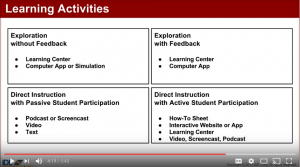Teaching should not be transactional; it should be transformational. The goal of teaching is to ensure that students gain a level of understanding of content that enables them to apply it to new situations, thus transforming them.
Learning comes from making sense and meaning of content (Sousa, 2011) and is enhanced when students have:
- a felt-need for the content
- time to explore and grapple with the content
- direct instruction in skills at the appropriate time in the appropriate modality
- time to practice skills and content application
The first bullet speaks to a teacher’s ability to inspire students. In the Learner-Active, Technology-Infused Classroom, that comes from the teacher providing students with an authentic, open-ended, real-world problem to solve, and from whole-group lessons that present concepts that leave students on the edges of their seats. Teachers can inspire through whole-class lessons: inspire big!
The remaining bullets are not accomplished through whole-group instruction, but through small venues: a small-group mini-lesson offered by the teacher; one-on-one or small-group facilitation by the teacher; independent learning activities; and peer assistance.  These are critical structures in a Learner-Active, Technology-Infused Classroom as they provide the most meaningful instruction and learning opportunities for students.
These are critical structures in a Learner-Active, Technology-Infused Classroom as they provide the most meaningful instruction and learning opportunities for students.
When you stand before the entire class, inspire! Trigger students’ awareness of new content they can use.
 Plan your lesson well; present for no more than 15 minutes; use a combination of voice and visuals. Do not teach skills! Skill development is a very complex process, taking place mostly through internal cognitive processing. Can some people listen to a teacher, cognitively process the information, and learn without missing the next sentence? Maybe. Can an entire class? Absolutely not; not even if they are all homogeneously grouped. Inspiration grabs students’ attention, focuses them, and causes them to generate questions they want answered. So you can inspire big! But . . .
Plan your lesson well; present for no more than 15 minutes; use a combination of voice and visuals. Do not teach skills! Skill development is a very complex process, taking place mostly through internal cognitive processing. Can some people listen to a teacher, cognitively process the information, and learn without missing the next sentence? Maybe. Can an entire class? Absolutely not; not even if they are all homogeneously grouped. Inspiration grabs students’ attention, focuses them, and causes them to generate questions they want answered. So you can inspire big! But . . .
Teach small! Provide ample opportunities for students to engage in a variety of learning activities. Offer small-group mini-lessons on targeted content aimed at varying levels of ability. Rather than a lesson on “perimeter,” offer lessons such as these:
- What Is Perimeter? (for beginners at the concept)
- Calculating Perimeter of a Square or Rectangle
- Calculating Perimeter of Various Polygons
- Understanding Circumference: The Perimeter of a Circle (advanced mini-lesson that requires passing an entrance quiz to receive a ticket)
Also consider what videos are available or can be recorded to present lessons. Students who need more time to think than the pace of the lesson can stop and rewind.
Following are some classroom snapshots where you can see the “teach small” concept in action:
Inspire big! Teach small! Change the world!
